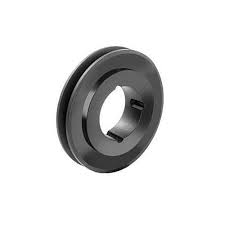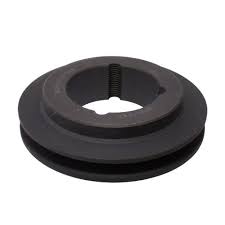Product Description
cast iron surface phosphate V type belt pulley
1) European standard:
a) V-belts pulley for taper bushing: SPZ, SPA, SPB, SPC; up to 10 grooves.
b) Adjustable speed V-belt pulleys and variable speed pulleys.
c) Flat belt pulleys and conveyor belt pulleys.
2) American standards:
a) Sheave for taper bushing: 3V, 5V, 8V
b) Sheaves for QD bushings: 3V, 5V, 8V
c) Sheaves for split taper bushing: 3V, 5V, 8V .
d) Sheave for 3L, 4L or A, and 5L or B belts: AK, AKH, 2AK, 2AKH, BK, BKH,2BK, 2BKH, 3BK
e) Adjustable sheave: poly V-pulley, multi-pitch H, L, J, K and M.
Fetures:
Made according to drawings and/or sample,OEM inquiries welcomed, especially for big pulley.
Material: C45, cast iron, ductile iron, GG200,GG250, GGG3000, GGG40, nylon, aluminum, etc.
Surface treatment: Black oxide, phosphate, painted, Zinc plate or passavited.
Bore: pilot bore, finish bore, taper bore, bore for QD bushing
Inspection:Dynamic balance & Static balance test are available.With standardized desigh and well equipped CNC machining Systems.
Our pulleys have high Precision and good interchangeability.
Apply to mining machinery,petroleum machinery ETC.
workshop
FAQ
Q: Are you trading company or manufacturer ?
A: We are factory.
Q: How long is your delivery time?
A: Generally it is 5-10 days if the goods are in stock. or it is 15-20 days if the goods are not in stock, it is according to quantity.
Q: Do you provide samples ? is it free or extra ?
A: Yes, we could offer the sample for free charge but do not pay the cost of freight.
Q: What is your terms of payment ?
A: Payment 30%TT in advance. 70% T/T before shippment
| Certification: | CE, ISO |
|---|---|
| Pulley Sizes: | Type B |
| Manufacturing Process: | Casting |
| Material: | Iron |
| Surface Treatment: | Polishing |
| Application: | Chemical Industry, Grain Transport, Mining Transport, Power Plant |
| Samples: |
US$ 16/Piece
1 Piece(Min.Order) | |
|---|
| Customization: |
Available
| Customized Request |
|---|

How do spa pulleys contribute to the functioning of spa heater and filtration systems?
Spa pulleys play a significant role in the functioning of spa heater and filtration systems. Here’s a detailed explanation of how spa pulleys contribute to these systems:
1. Spa Heater System:
Spa pulleys are involved in the operation of the spa heater system, which is responsible for maintaining the desired water temperature. The heater system typically includes a circulation pump that moves water through the heater element. The pump is driven by a motor connected to pulleys and belts or cables. The pulleys transmit power from the motor to the pump, ensuring water flow through the heater system.
Properly sized and aligned pulleys help maintain the appropriate speed and torque required for efficient water circulation. When the pulleys are correctly configured, they ensure that the pump operates at the optimal speed, allowing sufficient time for water to pass through the heater element and reach the desired temperature. This enables the heater system to effectively heat the water in the spa, providing a comfortable and enjoyable spa experience for users.
2. Spa Filtration System:
The spa filtration system is responsible for removing debris, particles, and contaminants from the spa water, promoting clean and clear water. Spa pulleys contribute to the functioning of the filtration system by powering the circulation pump that drives water through the filter media.
Similar to the spa heater system, the circulation pump is driven by a motor connected to pulleys and belts or cables. The pulleys transmit power from the motor to the pump, ensuring sufficient water flow through the filtration system. Proper alignment and tensioning of the pulleys help maintain consistent water flow, ensuring that water passes through the filter media effectively.
Effective power transmission through the pulleys allows the filtration system to efficiently capture and trap debris and contaminants, preventing them from re-entering the spa water. This contributes to improved water quality, reducing the risk of cloudy water or waterborne illnesses. Additionally, proper pulley alignment and tensioning minimize the risk of clogs or reduced filtration efficiency, ensuring continuous and effective filtration.
In summary, spa pulleys are essential for the functioning of spa heater and filtration systems. They enable the circulation pump to operate, facilitating water flow through the heater system for temperature regulation and through the filtration system for debris and contaminant removal. Proper alignment and tensioning of spa pulleys ensure optimal power transmission, allowing the systems to function efficiently and effectively. This helps maintain comfortable water temperature and promotes clean and clear spa water for an enjoyable and hygienic spa experience.

How are spa pulleys customized for specific spa makes and models?
Customizing spa pulleys for specific spa makes and models involves several considerations. Here’s a detailed explanation of the process:
1. Understanding Spa Requirements:
To customize spa pulleys, it is crucial to have a comprehensive understanding of the specific spa make and model. This includes knowledge of the motor specifications, pump requirements, and other driven components within the system. Understanding the power, speed, and torque requirements of the spa system helps in selecting or designing pulleys that will meet the precise needs of the spa.
2. Identifying Pulley Size and Ratio:
The size and ratio of the pulleys are key factors in customizing spa pulleys. By considering the motor speed and the desired speed of the driven component, the appropriate pulley sizes and ratios can be determined. Pulley size affects the rotational speed and torque output, while the ratio determines the speed relationship between the motor and the driven component. Careful calculations and analysis are performed to ensure the pulley dimensions and ratios align with the requirements of the specific spa make and model.
3. Pulley Material and Construction:
The choice of pulley material and construction is another aspect of customization. Different spa makes and models may have varying environmental conditions or operating parameters that require specific pulley materials. Factors such as temperature, moisture, and chemical exposure are considered when selecting materials that can withstand the spa environment. Additionally, the pulley’s construction, including its reinforcement and balancing features, may be tailored to enhance durability and performance based on the specific spa requirements.
4. Belt or Cable Compatibility:
Customizing spa pulleys also involves ensuring compatibility with the belts or cables used in the spa system. Pulleys must be designed to accommodate the specific belt or cable type, width, and thickness that are recommended by the spa manufacturer. The pulley’s design, such as groove shape, notch pattern, or tooth profile, should match the belt or cable to ensure proper engagement and grip. This compatibility ensures reliable power transmission and prevents slippage or premature wear.
5. Collaborative Design and Manufacturing:
In some cases, spa pulleys may be custom-designed and manufactured in collaboration with the spa manufacturer or a specialized pulley manufacturer. This collaborative approach allows for the development of pulleys that precisely meet the requirements of the specific spa make and model. The manufacturer’s expertise in pulley design, materials, and manufacturing processes ensures the production of high-quality pulleys tailored to the unique needs of the spa.
6. Quality Assurance and Testing:
Before integrating customized pulleys into the spa system, rigorous quality assurance and testing procedures are typically conducted. This ensures that the pulleys meet the required performance standards and operate safely within the spa environment. Testing may involve assessing factors such as power transmission efficiency, belt or cable engagement, and overall system functionality. Through these tests, any potential issues or improvements can be identified and addressed before finalizing the customized pulleys for the specific spa make and model.
By following these steps, spa pulleys can be customized to fit the specific requirements of different spa makes and models. This customization process ensures optimal performance, reliability, and compatibility, providing spa owners with pulleys that are specifically designed for their spa’s unique needs.

How do spa pulleys contribute to the operation of water circulation and jets?
Spa pulleys play a crucial role in the operation of water circulation and jets within a spa or hot tub system. Here’s a detailed explanation of how spa pulleys contribute to the operation of water circulation and jets:
1. Water Circulation:
In spa and hot tub systems, water circulation is essential for maintaining water quality, distributing heat evenly, and ensuring effective filtration. Spa pulleys are commonly used to connect the motor or drive source to the pump impeller. As the motor rotates, it drives the spa pulley, which then transfers rotational power to the pump impeller. The impeller creates a suction force that draws water into the pump and then pushes it through the filtration system and jets, facilitating water circulation throughout the spa or hot tub.
2. Jet Operation:
Jets in a spa or hot tub system are responsible for creating therapeutic water flow and pressure. Spa pulleys play a significant role in powering and controlling the jets. The motor or drive source is connected to the pump impeller via the spa pulley. As the impeller spins, it pressurizes the water, which is then directed through the jet nozzles. The spa pulley ensures that the impeller receives sufficient rotational power to generate the desired water flow and pressure, providing a soothing and invigorating hydrotherapy experience.
By transferring rotational power from the motor to the pump impeller, spa pulleys enable efficient water circulation and jet operation in the following ways:
Belt Engagement: The grooved or toothed surface of the spa pulley securely engages the belt, such as a V-belt or timing belt, preventing slippage. This ensures that the rotational power from the motor is effectively transferred to the pump impeller, promoting consistent water circulation and jet performance.
Power Transmission: The spa pulley acts as a mechanical link between the motor or drive source and the pump impeller. As the motor rotates, the pulley rotates as well, transmitting rotational power to the impeller. This power transmission drives the impeller’s spinning motion, creating the necessary water flow and pressure for water circulation and jet operation.
Pulley Ratio: In some cases, spa pulleys are designed with specific ratios to achieve desired speed or torque outputs. By selecting pulleys with the appropriate ratio, the rotational speed or torque can be adjusted to meet specific water circulation and jet performance requirements. This allows for customization and optimization of the system’s water movement and therapeutic effects.
Overall, spa pulleys are integral components that contribute to the smooth operation of water circulation and jets in spa and hot tub systems. They ensure the efficient transfer of rotational power from the motor to the pump impeller, facilitating proper water flow, pressure, and distribution throughout the system, as well as delivering an enjoyable hydrotherapy experience.


editor by CX
2023-09-25